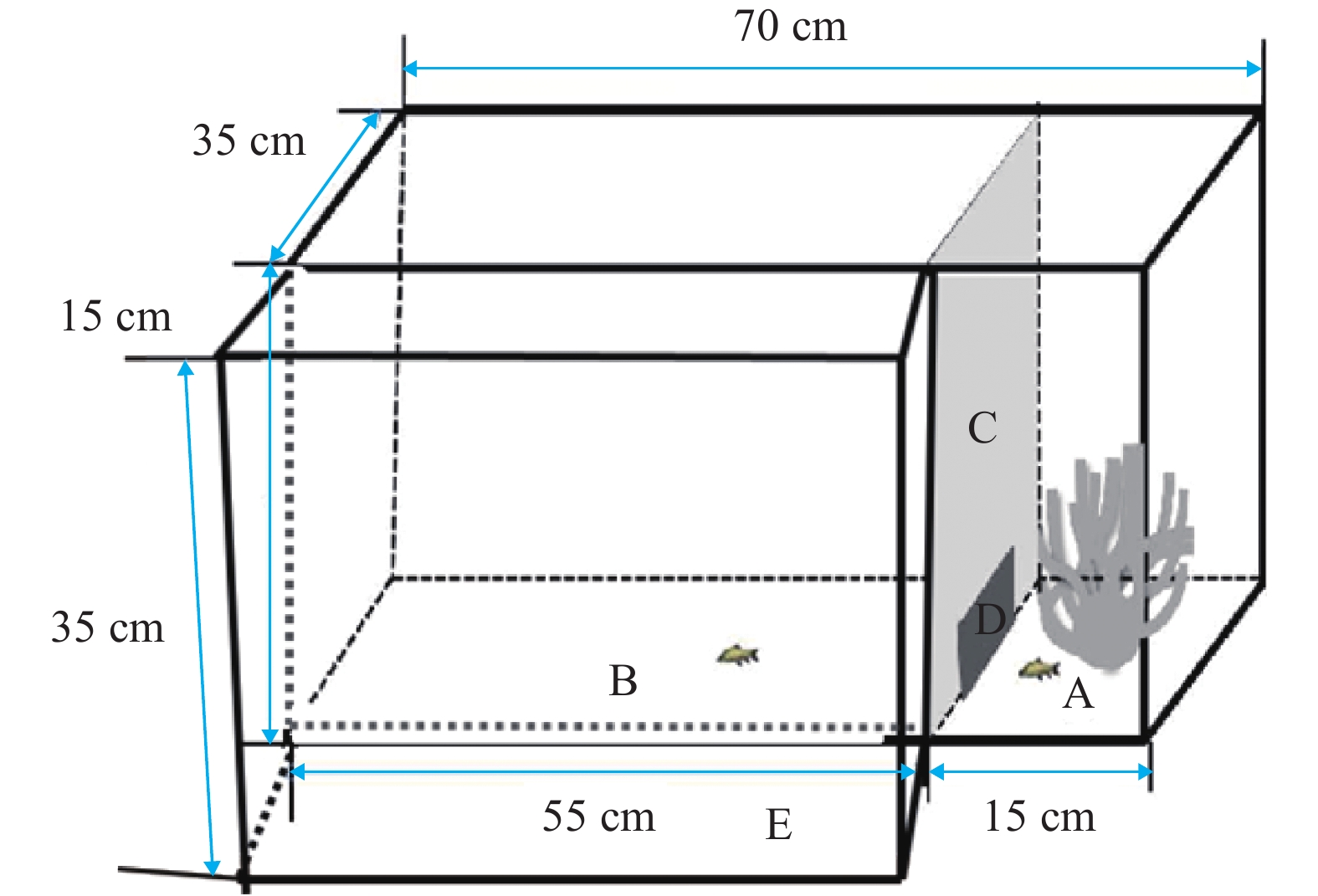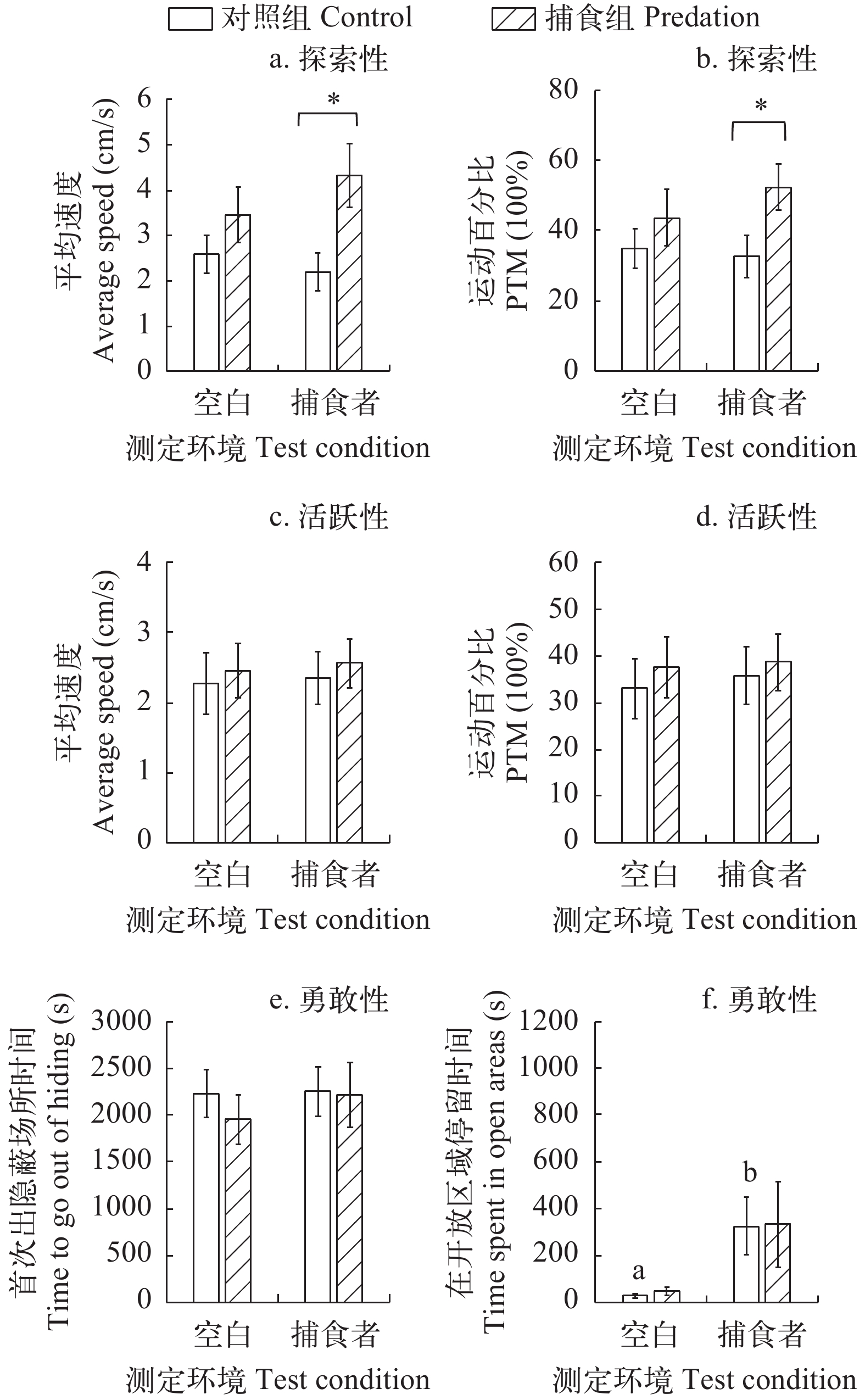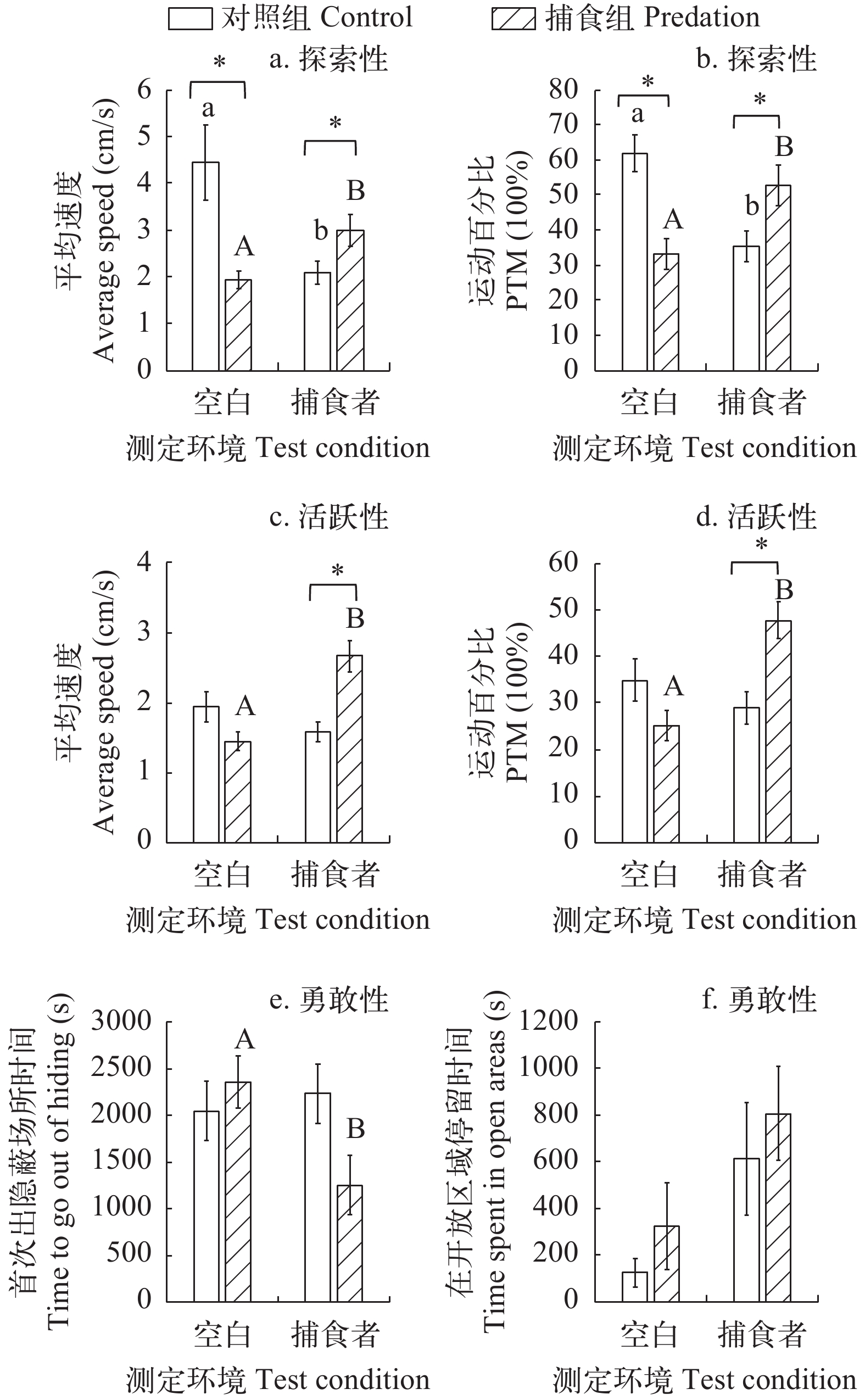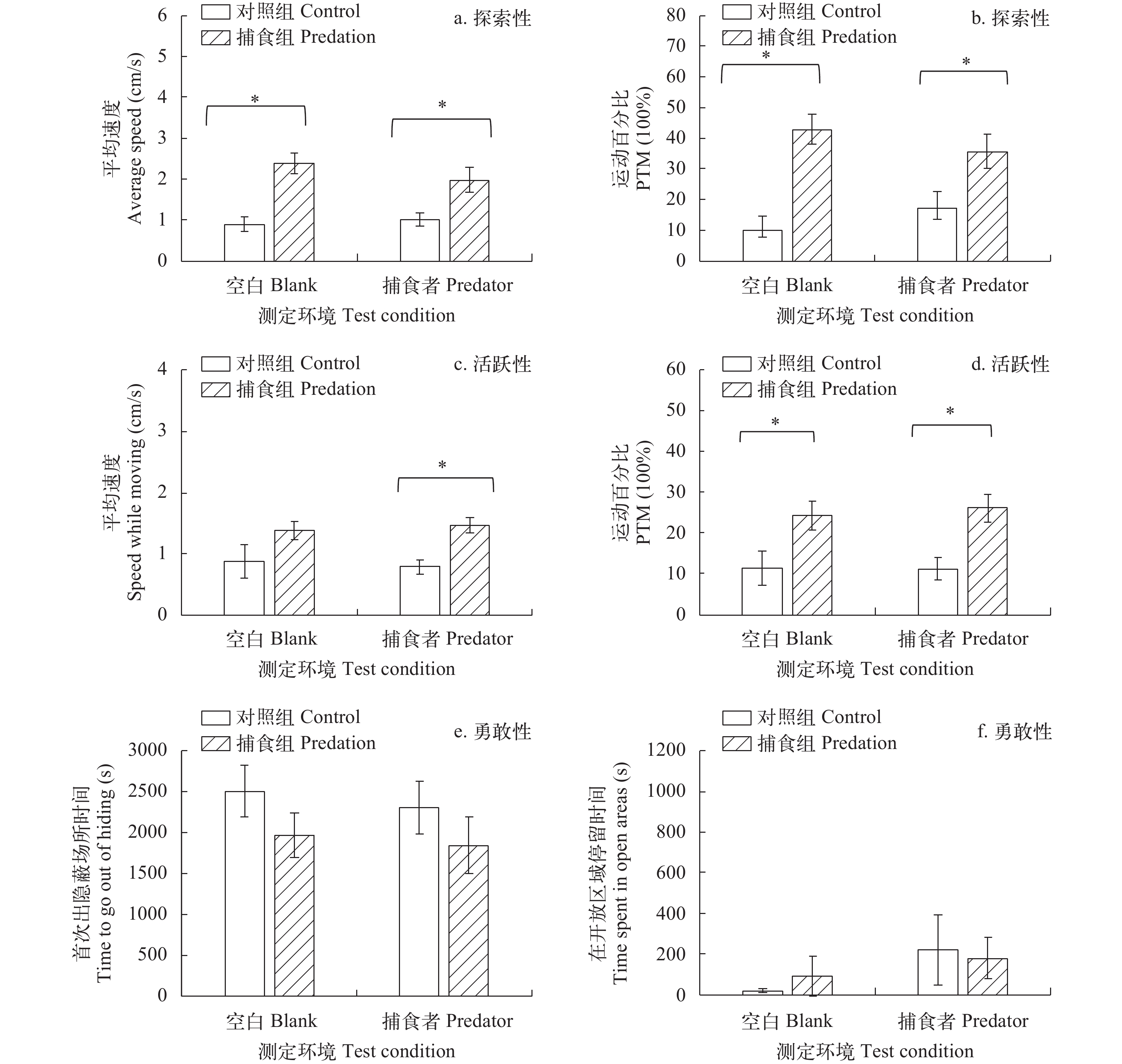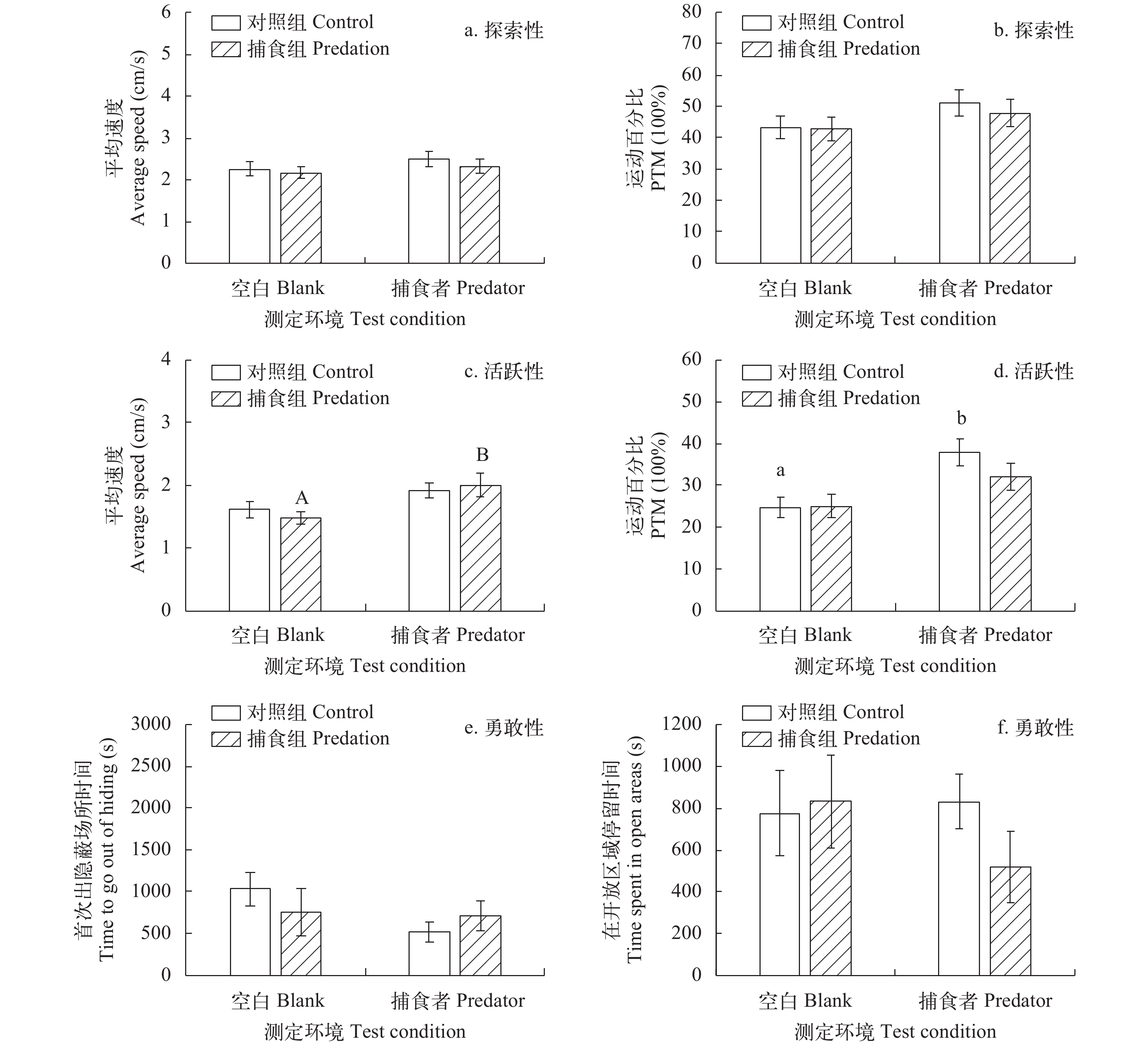INTERSPECIFIC COMPARISON OF THE BEHAVIORAL RESPONSES TO PREDATION STRESS IN FOUR CYPRINIDS
-
摘要: 为了比较早期捕食胁迫经历和当前环境中存在的捕食者对鱼类行为的影响, 并考查这些影响是否存在种间差异, 研究分别考查了测定环境(有、无捕食者存在)对有、无捕食胁迫经历的鳊(Parabramis pekinensis)、草鱼(Ctenopharyngodon idellus)、鲫(Carassius auratus)和中华倒刺鲃(Spinibarbus sinensis)等4种鲤科鱼类探索性、活跃性和勇敢性的影响。结果发现: 早期捕食胁迫经历与当前环境条件对鱼类行为产生截然不同的影响, 且存在较大的种间差异。无捕食胁迫经历的鳊、草鱼和中华倒刺鲃均会对陌生的捕食者乌鳢(Channa argus)做出行为响应, 提示这3种鱼可能对陌生捕食者具有一定的识别能力, 但这种识别与猎物鱼通过捕食胁迫经历获得的识别仍具有一定差距; 具有捕食胁迫经历的鳊和中华倒刺鲃在空白环境中未表现出反捕食行为, 可能是节约能量的一种策略。总体而言, 草鱼对捕食胁迫经历和测定环境处理反应更为敏感, 而中华倒刺鲃的反应则相对保守。但当周围环境中存在捕食者时, 4种鲤科鱼类均会通过维持较高运动状态的方式来应对捕食者。维持这种应激状态可能对猎物鱼保持与捕食者的距离, 并随时保持警惕较为关键。Abstract: In nature, fish often suffer from various of predation stress. Thus, prey fish often respond to their predators by adjusting their behavior, which is called anti-predator behavior. Investigating the correlations between behavioral characteristics of fishes and their physiological functions and habitat environment at the interspecific level is helpful to understand the internal mechanism of interspecific differentiation of behavioral strategies of fishes, therefore ecologically important. The previous predation stress experience and the presence of predators in the current environment may act different effects on the behavior of prey fish, because the prey fish need to maximize survival and minimize the cost of anti-predator behavior. The aims of this study were to compare the effects of previous predation stress experience and the presence of predators in the current environment on the behavior of prey fish, and to examine whether there are interspecific differences for these effects. In this study, the effects of both previous predation stress experience and present predation stress on exploration, activity and boldness in juvenile bream (Parabramis pekinensis), grass carp (Ctenopharyngodon idellus), crucian carp (Carassius auratus) and qingbo (Spinibarbus sinensis) were investigated. The results showed that, the effects of predation stress experienced early on the behavior of fish are quite different from those of predators in the current environment, and these effects are also quite different among the four species. The naïve bream, grass carp and qingbo performed anti-predator behavior to the strange predator snakehead fish (Channa argus), which suggested that these three fish could recognize the strange predator snakehead fish, but such a recognition is still different from the recognition obtained from real predation experience. The bream and qingbo with predation stress experience did not exhibited anti-predator behavior in blank environment, which may be a strategy for conserving energy. In general, grass carps were more sensitive to predation stress and environmental treatment, while the response of qingbo was more conservative. The differences in anti-predator responses among the four cyprinids may be closely related to the physiological phenotypes of the four cyprinids, such as morphology and swimming performance, and the predation pressure in the habitat environment. In terms of similarities, all the four species respond to predators by maintaining high levels of swimming in the presence of predators. Maintaining this stress state may be critical to keeping the prey fish stay away from the predator and staying alert at all times.
-
Keywords:
- Predation stress /
- Anti-predator behavior /
- Cyprinids /
- Interspecies difference /
- Identification
-
在自然界中, 动物经常遭受不同形式的捕食胁迫。有研究者认为, 捕食者对猎物种群产生的非致命性影响通常大于直接的致命性捕食[1]。虽然动物种群中只有少数个体真正会被捕食者捕食, 但是大部分个体由于捕食胁迫的存在(非致命性影响), 主动或被动的在形态、生理及行为等方面表现出反捕食响应[1-4]。例如来自高捕食压力种群的黑鲫(Carassius carassius), 其体高及快速启动逃逸能力(最大速度、最大加速度等)均显著高于低捕食压力的种群[5]; 在遭遇捕食者后, 澳氏雀鲷(Pomacentrus wardi)显著降低冒险行为以提高生存能力[4]。相较于低捕食压力的埃氏短棒鳉(Brachyrhaphis episcopi)种群, 来自高捕食压力种群的同类具有更高的活跃性和探索性, 对胁迫表现出更低的应激反应[6]。在诸多反捕食策略中, 鱼类行为调节通常更为迅速和高效, 对于猎物鱼应对捕食胁迫至关重要, 因此一直备受研究者关注[7-9]。
鱼类行为特征中的探索性(Exploration, 个体对潜在捕食者、新栖息地和食物的行为反应)、活跃性(Activity, 个体由肌肉活动引发的运动行为状态)和勇敢性(Boldness, 个体对已知环境危险状况的反应)与鱼类逃避捕食者密切相关[10]。在自然界中鱼类种类繁多, 其在生理、生化特征和栖息地环境等方面的种间差异均可能对鱼类的上述行为特征产生重要影响[11, 12], 进而影响鱼类对捕食胁迫的行为响应策略。然而到目前相关研究主要关注特定鱼类的反捕食行为, 关于鱼类对捕食胁迫行为响应策略的种间比较鲜有报道。鱼类反捕食行为的种间比较有利于在种间水平建立鱼类行为特征与生理功能及栖息环境等的关联, 进而理解鱼类行为策略种间分化的内在机制, 因此具有一定的理论意义。
在遭遇捕食者时, 鱼类可能会表现出反捕食行为以应对当前的威胁[2, 13, 14]。然而当捕食者暂时消失后, 鱼类的行为如何变化则是非常有趣的问题。因为持续维持反捕食行为有利于其提高下次遭遇捕食者时的存活率[4], 但多数反捕食行为都是有代价的, 例如增加对捕食者的探索行为会增加能量消耗, 提高隐蔽场所利用率则会降低鱼类获取食物等资源的几率[15]。因此, 早期经历的捕食胁迫和当前环境中存在的捕食者对于鱼类的影响可能是截然不同的。由此, 本研究目的旨在分别考查前期捕食胁迫经历和当前环境中存在的捕食胁迫对猎物鱼行为的影响, 并探讨该影响是否存在种间差异。
为了探讨鱼类反捕食行为策略种间分化的内在机制, 本研究选择鳊(Parabramis pekinensis)、草鱼(Ctenopharyngodon idellus)、鲫(Carassius auratus)和中华倒刺鲃(Spinibarbus sinensis)等4种同水域生存的鲤科鱼类幼鱼作为猎物鱼, 以其水域常见的天敌之一乌鳢(Channa argus)为捕食者。分别考查了前期捕食胁迫经历(有、无捕食胁迫经历)和测定环境(测定环境中有、无捕食者存在)对4种鲤科鱼类探索性、活跃性和勇敢性的影响。
1. 材料与方法
1.1 实验鱼的来源与驯养
实验中用到的猎物鱼鳊(1.3—3 g, n=200)、草鱼(2—5 g, n=200)、鲫(2—4 g, n=200)和中华倒刺鲃(3—5 g, n=200)均购自重庆市合川区水产养殖基地。捕食者乌鳢(500—600 g, n=20)来源于重庆市南川区乌鳢养殖场。5种实验鱼分别置于长方形养殖水槽(2 m×1 m×0.5 m, 1000 L)中进行15d以上的驯养。在水槽中装入曝气后的自来水, 并且用充气泵不停地向水中充入空气保证到水中的溶氧水平接近饱和。每天上午10:00用解冻后的赤虫(中国滨海骏业生物公司)搭配商业饵料对4种猎物鱼进行饱足投喂1次; 捕食者乌鳢每隔2天使用新鲜的鲢肉片搭配商业饵料投喂至饱足1次。所有实验鱼均在投喂1h后用虹吸管清理剩余饵料和粪便, 然后进行每天1次的换水, 日换水量约10%。在驯养过程中水温控制在(25±1)℃, 光周期为12L﹕12D。
1.2 实验方案
驯养完成的鳊、草鱼、鲫和中华倒刺鲃, 每种鱼均随机分为2组: 对照组和捕食(捕食胁迫经历)组。对照组按照驯养期间的养殖条件继续喂养, 捕食组猎物鱼与捕食者乌鳢在同一个水槽中混养, 但通过铁丝网将猎物鱼和捕食者分隔开[16]。为强化猎物鱼的被捕食风险, 避免猎物鱼因无法被直接捕食导致其对捕食者无行为反应, 在混养水槽的捕食者一侧放入不用于实验测定的饵料鱼, 供捕食者捕食, 以对铁丝网另一侧的猎物鱼构成视觉和嗅觉等层面的刺激。捕食组除水槽中存在捕食者外, 其他养殖环境与对照组完全相同。15d后选择身体健康、大小接近的4种猎物鱼各20尾(体重、体长等数据见表 1), 选择单尾鱼分别在周围可视环境中有、无捕食者乌鳢的条件下测定探索性、活跃性和勇敢性。实验过程中水温均维持在(25±1)℃。
表 1 不同组实验鱼的体重、体长和样本量(平均值±SE)Table 1. The body weight, body length and sample size of different groups (mean±SE)种类
Species前期处理
Preprocessing测定环境
Test conditions样本量
Sample size体重
Body mass (g)体长
Body length (cm)鳊
Parabramis pekinensis对照 空白 n=20 2.49±0.12 5.40±0.10 捕食者 n=20 2.78±0.16 5.60±0.09 捕食经历 空白 n=20 2.22±0.16 5.15±0.10 捕食者 n=20 2.34±0.19 5.18±0.13 草鱼
Ctenopharyngodon idellus对照 空白 n=20 2.98±0.12 5.64±0.09 捕食者 n=20 3.45±0.28 5.84±0.17 捕食经历 空白 n=20 3.31±0.23 5.67±0.12 捕食者 n=20 3.15±0.21 5.63±0.12 鲫
Carassius auratus对照 空白 n=20 3.02±0.16 5.03±0.09 捕食者 n=20 3.19±0.16 5.17±0.09 捕食经历 空白 n=20 3.30±0.27 5.17±0.15 捕食者 n=20 3.06±0.19 5.16±0.11 中华倒刺鲃
Spinibarbus sinensis对照 空白 n=20 4.24±0.24 6.12±0.11 捕食者 n=20 4.19±0.30 6.06±0.15 捕食经历 空白 n=20 3.95±0.22 5.97±0.10 捕食者 n=20 4.36±0.30 6.16±0.13 1.3 探索性、活跃性和勇敢性的测定
在本研究中探索性、活跃性和勇敢性都采用实验室自制的行为观察装置(图 1)完成测定。该行为观察装置通过有机玻璃板组装成长方体水槽(70 cm×35 cm×35 cm), 将水槽用不透明的有机玻璃板分隔成2个区域: 开阔区(55 cm×35 cm×35 cm)和隐蔽区(15 cm×35 cm×35 cm)两部分。上述不透明有机玻璃板底部正中央有一个可以打开和关闭的小门(10 cm×10 cm), 小门打开时, 实验鱼可在开阔区和隐蔽区之间来回穿梭。隐蔽区内放置有塑料水草, 可为实验鱼提供隐蔽场所。行为观察装置的3个侧面和底面均覆盖有白色广告纸, 用以减少外界环境干扰, 同时增大实验鱼与背景环境的反差, 方便后期视频分析; 观察装置的正面保持透明, 该侧平行放置另一个刺激水槽(55 cm×15 cm×35 cm), 用于放置捕食者, 给予猎物鱼视觉刺激。行为测定水槽及刺激水槽中水深均为10 cm, 以降低实验鱼在水体中的垂直移动[17]。实验鱼位于行为观察水槽的开阔区时可清楚地观察到刺激水槽中的状况。行为测定时, 刺激水槽中未放入捕食者乌鳢即为无捕食者存在的空白环境; 放入捕食者乌鳢则为有捕食者存在的环境。行为测定水槽上方安装有与计算机连接的高清摄像头(罗技Pro 9000), 用以拍摄实验鱼的探索性、活跃性和勇敢性。
猎物鱼和捕食者在行为测定前禁食48h, 以避免消化过程对行为的影响。分别在测定环境有、无捕食者存在的情况下进行探索性、活跃性和勇敢性的测定: 将单尾实验鱼带水转移至上述行为测定装置的开阔区域中(小门为关闭状态), 随后立即通过摄像头拍摄猎物鱼对陌生环境的探索行为, 持续20min, 即为探索性。40min后, 猎物鱼基本上已完成对周围环境的探索并逐步适应, 随后开始另外20min的拍摄作为活跃性。在活跃性拍摄完成后, 将开阔区和隐蔽区之间的小门打门, 用渔网快速下坠的方式(模拟捕食者袭击)将猎物鱼通过小门赶入隐蔽区域, 随后进行60min的勇敢性拍摄, 期间小门持续打开。通过摄像头记录猎物鱼第1次从隐蔽区域进入开阔区域所用的时间及实验鱼在开阔区域的累计停留时间。若猎物鱼在60min内都未曾进入开阔区域则视为: 猎物鱼进入开阔区域的时间为1h, 在开阔区域累计停留时间为0。所有视频拍摄完成后通过“格式工厂”转码成avi.(15帧/s)格式, 然后采用动物运动轨迹跟踪软件EthoVision XT 9.0 (Noldus, Netherlands)对视频进行分析。探索性指标为实验鱼在陌生环境中的平均速度(cm/s)和运动时间比(%); 即为运动的时间占总时间的百分比, 其中运动状态的判断标准为实验鱼质心的移动速度大于1.75 cm/s[18]; 活跃性指标为实验鱼在熟悉环境中的平均速度(cm/s)和运动时间比(%); 勇敢性指标为实验鱼受到“袭击”后首次出隐蔽场所时间(s)和在开阔区域累计停留时间(s)。
1.4 数据统计与分析
原始实验数据经过Excel 2010进行常规计算后, 使用SPSS软件(SPSS 17.0)对数据进行统计分析。前期捕食胁迫经历和测定环境对鳊、草鱼、鲫和中华倒刺鲃探索性、活跃性和勇敢性的影响使用双因素协方差分析, 体重作为协变量。若捕食胁迫经历和测定环境的影响显著则进一步使用t检验做事后检验。所有的统计数据均以平均值±标准误(Mean±SE)表示, 显著水平为P<0.05。
2. 结果
2.1 捕食胁迫经历和测定环境对鳊幼鱼探索性、活跃性和勇敢性的影响
前期的捕食胁迫经历显著影响鳊幼鱼的探索性(平均速度, F1,73=7.026, P=0.010; 运动百分比, F1,73=4.912, P=0.030; 表 2)。当测定环境中存在捕食者时, 捕食组鳊幼鱼的探索性(平均速度、运动百分比)显著高于对照组(P<0.05; 图 2a和2b)。前期捕食胁迫经历和测定环境对鳊幼鱼活跃性(平均速度、运动百分比)的影响均不显著(表 2)。测定环境对鳊幼鱼勇敢性(在开放区域停留时间)的影响显著(F1,75=6.532, P=0.013; 表 2)。对照组的鳊幼鱼在有捕食者存在时表现出更高的勇敢性(在开放区域停留时间, P=0.02; 图 2f)。
表 2 捕食胁迫经历和测定环境对鳊幼鱼探索性、活跃性和勇敢性的影响Table 2. Effects of predation experience and measuring environment on exploration, activity and boldness in juvenile bream行为
Behavior指标
Index协变量(体重)
Covariate (Body mass)前期处理
Preprocessing测定环境
Test condition交互作用
Interaction探索性
Exploration平均速度(cm/s) F1.73=0.010
P=0.920F1.73=7.026
P=0.010F1.73=0.170
P=0.681F1.73=1.131
P=0.256运动百分比(%) F1.73=0.252
P=0.618F1.73=4.912
P=0.030F1.73=0.170
P=0.682F1.73=0.715
P=0.400活跃性
Activity平均速度(cm/s) F1.75=0.003
P=0.959F1.75=0.228
P=0.634F1.75=0.058
P=0.811F1.75=0.001
P=0.980运动百分比(%) F1.75=0.069
P=0.794F1.75=0.268
P=0.606F1.75=0.108
P=0.744F1.75=0.025
P=0.874勇敢性
Boldness首次出隐蔽场所时间(s) F1.75=0.198
P=0.657F1.75=0.433
P=0.513F1.75=0.294
P=0.589F1.75=0.148
P=0.702在开放区域停留时间(s) F1.75=0.034
P=0.854F1.75=0.035
P=0.852F1.75=6.532
P=0.013F1.75=0.002
P=0.946![]() 图 2 捕食胁迫经历和测定环境对鳊幼鱼探索性、活跃性和勇敢性的影响不同的小写字母(a, b)代表对照组的实验鱼在不同测定环境下相关参数差异显著(P<0.05); 不同的大写字母(A, B)代表捕食组实验鱼在不同测定环境下相关参数差异显著(P<0.05); *表示在空白或捕食者存在环境下, 对照组与捕食者的相关参数差异显著(P<0.05); 下同Figure 2. Effects of predation experience and measuring environment on exploration, activity and boldness in juvenile breamDifferent lowercase letters (a, b) represent the significant differences between different measuring environment of the fish in the control group (P<0.05). The different uppercase letters (A, B) represent the significant differences between different measuring environment of the fish in the predation group (P<0.05). * indicates the significant differences between control and predation groups in either blank or predator present environment (P<0.05), the same applies below
图 2 捕食胁迫经历和测定环境对鳊幼鱼探索性、活跃性和勇敢性的影响不同的小写字母(a, b)代表对照组的实验鱼在不同测定环境下相关参数差异显著(P<0.05); 不同的大写字母(A, B)代表捕食组实验鱼在不同测定环境下相关参数差异显著(P<0.05); *表示在空白或捕食者存在环境下, 对照组与捕食者的相关参数差异显著(P<0.05); 下同Figure 2. Effects of predation experience and measuring environment on exploration, activity and boldness in juvenile breamDifferent lowercase letters (a, b) represent the significant differences between different measuring environment of the fish in the control group (P<0.05). The different uppercase letters (A, B) represent the significant differences between different measuring environment of the fish in the predation group (P<0.05). * indicates the significant differences between control and predation groups in either blank or predator present environment (P<0.05), the same applies below2.2 捕食胁迫经历和测定环境对草鱼幼鱼探索性、活跃性和勇敢性的影响
前期捕食胁迫经历和测定环境对草鱼幼鱼探索性2个指标的影响均不显著, 但2种因素对这2个指标的影响均存在显著的交互作用(平均速度F1.75=11.958, P=0.001; 运动百分比F1.75=18.784, P=0.001; 表 3)。在环境中无捕食者时, 捕食胁迫经历导致草鱼幼鱼探索性(平均速度和运动百分比)显著降低(P<0.05); 但当环境中存在捕食者时, 前期捕食胁迫经历导致草鱼幼鱼探索性(平均速度和运动百分比)显著提高(P<0.05; 图 3a和3b)。在环境中出现捕食者时, 对照组草鱼表现出探索性(平均速度和运动百分比)的显著降低, 而捕食组却表现出探索性的显著提高(P<0.05; 图 3a和3b)。
表 3 捕食胁迫经历和测定环境对草鱼幼鱼探索性、活跃性和勇敢性的影响Table 3. Effects of predation experience and measuring environment on exploration, activity and boldness in juvenile grass carp行为
Behavior指标
Index协变量(体重)
Covariate (Body mass)前期处理
Preprocessing测定环境
Test condition交互作用
Interaction探索性
Exploration平均速度(cm/s) F1.75=0.640
P=0.426F1.75=2.905
P=0.092F1.75=1.714
P=0.194F1.75=11.958
P=0.001运动百分比(%) F1.75=0.922
P=0.340F1.75=1.255
P=0.266F1.75=0.378
P=0.541F1.75=18.784
P=0.000活跃性
Activity平均速度(cm/s) F1.75=1.089
P=0.300F1.75=2.676
P=0.106F1.75=5.932
P=0.017F1.75=16.393
P=0.000运动百分比(%) F1.75=1.814
P=0.182F1.75=1.440
P=0.234F1.75=5.183
P=0.026F1.75=12.086
P=0.001勇敢性
Boldness首次出隐蔽场所时间(s) F1.74=0.740
P=0.392F1.74=1.086
P=0.301F1.74=1.920
P=0.170F1.74=4.727
P=0.033在开放区域停留时间(s) F1.74=2.263
P=0.137F1.74=1.083
P=0.301F1.74=6.297
P=0.014F1.74=0.046
P=0.831测定环境对草鱼幼鱼活跃性2个指标的影响显著(平均速度F1.75=5.932, P=0.017; 运动百分比F1.75=5.183, P=0.026), 且2个因素对活跃性(平均速度和运动百分比)的影响存在交互作用(平均速度F1.75=16.393, P=0.000; 运动百分比F1.75=12.086, P=0.001; 表 3)。当环境中存在捕食者时, 前期捕食胁迫经历导致草鱼幼鱼活跃性(平均速度和运动百分比)显著提高(P<0.05; 图 3c和3d)。此外, 在环境中捕食者的出现导致捕食组草鱼活跃性(平均速度和运动百分比)显著提高(P<0.001; 图 3c和3d)。
前期捕食胁迫经历和测定环境对草鱼幼鱼勇敢性的2个指标的影响均不显著, 但2个因素对首次出隐蔽场所时间的影响存在显著的交互作用(F1.74=4.727, P=0.033; 表 3)。当环境中存在捕食者时, 前期捕食胁迫经历导致草鱼首次出隐蔽场所时间的显著降低(P=0.039; 图 3e); 环境中捕食者的存在导致捕食组草鱼首次出隐蔽场所时间显著缩短(P=0.013; 图 3e)。测定环境对草鱼勇敢性指标中的在开放区域停留时间影响显著(F1.74=6.297, P=0.014; 表 3)。但环境中出现捕食者时, 对照组(P=0.057)与捕食组(P=0.084)草鱼在开放区域停留时间均未表现出显著变化(图 3f)。
2.3 捕食胁迫经历和测定环境对鲫幼鱼探索性、活跃性和勇敢性的影响
前期捕食胁迫经历处理(平均速度F1.73=31.595, P<0.001; 运动百分比F1.73=39.331, P<0.001)和体重(平均速度F1.73=7.742, P=0.007; 运动百分比F1.73=7.883, P=0.006)对鲫幼鱼探索性的2个指标均有显著性影响(表 4)。无论在环境中有无捕食组, 捕食组鲫幼鱼的探索性(平均速度和运动百分比)均显著高于对照组(P<0.05; 图 4a和4b)。
表 4 捕食胁迫经历和测定环境对鲫幼鱼探索性、活跃性和勇敢性的影响Table 4. Effects of predation experience and measuring environment on exploration, activity and boldness in juvenile crucian carp行为
Behavior指标
Index协变量(体重)
Covariate (Body mass)前期处理
Preprocessing测定环境
Test condition交互作用
Interaction探索性
Exploration平均速度(cm/s) F1.73=7.742
P=0.007F1.73=31.595
P<0.001F1.73=0.357
P=0.552F1.73=0.782
P=0.379运动百分比(%) F1.73=7.883
P=0.006F1.73=39.331
P<0.001F1.73=0.003
P=0.958F1.73=2.055
P=0.156活跃性
Activity平均速度(cm/s) F1.74=0.190
P=0.664F1.74=10.574
P=0.002F1.74=0.000
P=1.000F1.74=0.268
P=0.607运动百分比(%) F1.74=0.086
P=0.770F1.74=15.440
P<0.001F1.74=0.050
P=0.823F1.74=0.110
P=0.741勇敢性
Boldness首次出隐蔽场所时间(s) F1.75=1.073
P=0.304F1.75=2.378
P=0.127F1.75=0.269
P=0.606F1.75=0.000
P=0.987在开放区域停留时间(s) F1.75=2.842
P=0.096F1.75=0.011
P=0.196F1.75=2.445
P=0.122F1.75=0.146
P=0.704前期捕食胁迫经历处理对鲫幼鱼活跃性指标中的平均速度(F1.74=10.574, P=0.002)、运动百分比(F1.74=15.440, P<0.001)均影响显著(表 4)。当环境中存在捕食者时, 相比对照组, 具有捕食胁迫经历的鲫幼鱼表现出更高的活跃性(平均速度和运动百分比; P<0.01; 图 4c和4d)。此外, 在空白环境中, 相比对照组, 捕食组鲫幼鱼也表现出更高的活跃性(运动百分比; P=0.025; 图 4d)。但前期捕食胁迫经历和测定环境均对鲫幼鱼的勇敢性无显著性影响(表 4)。
2.4 捕食胁迫经历和测定环境对中华倒刺鲃幼鱼探索性、活跃性和勇敢性的影响
仅体重对中华倒刺鲃幼鱼的探索性(平均速度, F1.74=4.914, P=0.030; 运动百分比, F1.74=7.758, P=0.007)表现出显著性影响(表 5)。
表 5 捕食胁迫经历和测定环境对中华倒刺鲃幼鱼探索性、活跃性和勇敢性的影响Table 5. Effects of predation experience and measuring environment on exploration, activity and boldness in juvenile qingbo行为
Behavior指标
Index协变量(体重)
Covariate (Body mass)前期处理
Preprocessing测定环境
Test condition交互作用
Interaction探索性
Exploration平均速度(cm/s) F1.74=4.914
P=0.030F1.74=0.709
P=0.402F1.74=0.929
P=0.338F1.74=0.272
P=0.604运动百分比(%) F1.74=7.758
P=0.007F1.74=0.261
P=0.611F1.74=2.076
P=0.154F1.74=0.506
P=0.479活跃性
Activity平均速度(cm/s) F1.74=0.340
P=0.562F1.74=0.017
P=0.897F1.74=8.218
P=0.005F1.74=0.428
P=0.515运动百分比(%) F1.74=1.273
P=0.263F1.74=0.851
P=0.359F1.74=11.189
P=0.001F1.74=1.311
P=0.256勇敢性
Boldness首次出隐蔽场所时间(s) F1.75=0.926
P=0.339F1.75=0.045
P=0.833F1.75=1.655
P=0.202F1.75=1.468
P=0.229在开放区域停留时间(s) F1.75=0.296
P=0.588F1.75=0.441
P=0.508F1.75=0.544
P=0.463F1.75=1.069
P=0.305测定环境对中华倒刺鲃幼鱼的活跃性(平均速度, F1.74=8.218, P=0.005; 运动百分比, F1.74=11.189, P=0.001)影响显著(表 5)。具有捕食胁迫经历的中华倒刺鲃在环境中有捕食者存在时表现出更高的平均速度(P=0.021; 图 5c); 而无捕食胁迫经历的中华倒刺鲃在环境中有捕食者存在时表现出更高的运动百分比(P=0.003; 图 5d)。前期捕食胁迫经历和测定环境均对中华倒刺鲃幼鱼的勇敢性无显著性影响(表 5)。
3. 讨论
反捕食行为是鱼类应对环境中捕食者的重要方式之一, 对于其提高捕食胁迫下的生存几率至关重要[2, 19]。例如增加的对捕食者的探索行为有利于猎物鱼获取更多的捕食者信息进而利于其做出更合理的应对策略[6]; 减少的觅食行为可降低猎物鱼被捕食者发现的概率[8]。但是, 反捕食行为所带来的觅食和生长的下降等不利影响可能会导致猎物鱼在下一生活史阶段的生存能力降低[4, 20], 也即当前生存与未来生存可能存在权衡。因此, 猎物可能根据捕食胁迫的程度对反捕食行为做出调整可以降低反捕食行为所带来的代价。已有研究发现, 孔雀鱼(Poecilia reticulata)对饱足状态下的捕食者表现出较少的反捕食行为[21]; 当前环境中无捕食者时, 来自高捕食压力种群的宽鳍鱲(Zacco platypus)并未增加隐蔽场所的利用率[8]。本研究旨在考查早期遭遇的捕食胁迫经历和当前环境中存在的捕食胁迫对猎物鱼的影响是否一致, 及这种影响是否存在种间差异。
3.1 捕食胁迫对四种鲤科鱼类探索性、活跃性和勇敢性的影响
在本研究中, 仅在当前环境中有捕食者的情况下, 前期有捕食胁迫经历的鳊幼鱼表现出提高的探索性, 表明前期的捕食胁迫经历对猎物鱼对捕食者做出识别和行为反应具有重要作用[22, 23]。以往关于鳊的研究也有类似的发现[22, 24]。而当环境中无捕食者时上述结果不复存在, 这可能是一种在非危险状态下减少反捕食行为以降低能量代价的行为策略。例如来自高捕食压力种群的宽鳍鱲, 在当前环境中无捕食者时并未提高隐蔽场所利用率[8]。此外, 无论早期是否有捕食胁迫经历, 在环境中有捕食者时鳊幼鱼均变得更为勇敢(对照组和捕食组在开放区域停留时间分别提高了10倍和5倍; 捕食组P=0.140未达到显著水平)。这表明在遭遇捕食者时, 鳊幼鱼倾向于较为积极和对抗的行为策略。这可能与鳊本身具有较高的攻击性有关。另外鳊为侧扁型鱼类, 体高很高, 因此很容易对捕食者形成口裂限制, 再加上其相对较强的运动能力[25], 捕食者对其威胁较为有限。
草鱼在空白环境下捕食胁迫经历导致探索性的降低, 而在捕食者存在情况下, 捕食胁迫经历导致探索性的提高。活跃性的结果也颇为类似, 尽管在空白环境下对照组与捕食组草鱼的活跃性显著并不差异。可能因为对于草鱼而言, 在空白的环境中, 具有捕食胁迫经历的草鱼通过降低探索性和活跃性来降低自己被潜在捕食者发现的几率。而当较小的开放环境中已经出现了捕食者, 即使降低活跃性也无法避免猎物鱼被捕食者发现, 维持较高的运动状态, 时刻对捕食者保持警惕反而会更加利于生存[16, 26]。值得注意的是, 对照组草鱼在环境中存在捕食者时出现了探索性的降低。可能因为其缺乏捕食胁迫经历, 进而对陌生的捕食者乌鳢并不了解, 因此暂时维持了较低的运动水平。另外, 结果发现, 前期捕食胁迫经历(捕食者存在的情况下)和环境中捕食者的出现均导致草鱼幼鱼勇敢性的提高, 这可能也与捕食胁迫导致的应激反应有关, 也即在捕食胁迫存在情况下, 草鱼采取了较为积极的行为应对策略。从整体上, 就草鱼而言, 前期遭遇的捕食胁迫经历和当前环境中遭遇的捕食者对其探索性、活跃性和勇敢性的影响较为类似。也侧面反映出草鱼对捕食胁迫更为敏感, 早期遭遇捕食胁迫造成的影响在无捕食者环境中依然保留。
无论测定环境中有、无捕食者的出现, 具有捕食胁迫经历的鲫幼鱼均表现出更高的探索性和活跃性。这表明无捕食胁迫经历的鲫幼鱼对其陌生捕食者乌鳢缺乏有效的识别, 因而未能做出适当的响应。反观捕食组的鲫幼鱼, 与草鱼类似, 早期经历的捕食胁迫使其一直维持着一定程度的应激状态, 尽管这会带来更高的能量代价[13], 但这种状态的维持会提高鲫幼鱼再次遭遇相同捕食者时的生存能力[27], 表明鲫幼鱼可能采取的是一种牺牲生长而保障生存的适应策略。
中华倒刺鲃的探索性和勇敢性均未对捕食胁迫做出响应。然而, 活跃性的不同指标(平均速度和运动百分比)却反映: 无论有无前期的捕食胁迫经历, 在环境中出现的捕食者均会导致中华倒刺鲃活跃性的提高。这说明中华倒刺鲃也同样通过维持较高的运动状态来应对环境中已经存在的捕食者。刘海生等[16]也曾发现经过捕食者南方鲇(Silrurus meridionalis)暴露处理的中华倒刺鲃活跃性明显提高, 与本研究结果较为一致。另外, 与鳊和草鱼类似, 无捕食胁迫经历的中华倒刺鲃也会对陌生的捕食者乌鳢做出一定程度的行为响应, 表明这3种鱼对陌生的捕食者乌鳢均具有一定的识别能力, 这与最近关于中华倒刺鲃的研究结果较为类似[13]。值得注意的是, 这种“识别”与猎物鱼通过捕食胁迫经历获得的识别仍具有较大差距[13]。尽管如此, 在生境中遭遇陌生的捕食者时尽快识别该捕食者并做出反应对于猎物鱼提高生存能力依然是十分必要的。
3.2 四种鲤科鱼类反捕食行为的种间比较
高捕食压力环境中的埃氏短棒鳉比低捕食压力环境中的同类, 表现出更高的勇敢性、活跃性和探索性[27, 28]。然而鲈(Perca fluviatilis)却刚好与其相反, 在低捕食压力环境中表现出更高的勇敢性[29]。对比之下, 本研究中捕食胁迫经历和测定环境对鳊、草鱼、鲫和中华倒刺鲃的影响也存在较大的种间差异。草鱼明显对捕食胁迫经历处理和测定环境的影响反应更为敏感, 而中华倒刺鲃的反应则相对保守; 另外前期经历过捕食胁迫的鲫持续维持一定程度的反捕食行为, 这可能是其能在高捕食压力的生境中广泛分布的重要原因之一[26]。4种鲤科鱼类反捕食响应的种间差异可能与不同鱼种自身的生理表型(如体高的大小和逃逸能力的强弱)和栖息环境中的捕食压力有着紧密的联系。4种鲤科鱼类反捕食响应的相似之处则体现在: 当前环境中存在捕食者时, 4种鲤科鱼类大部分会通过维持较高运动状态的方式来应对捕食者。早期经历的捕食胁迫与当前环境中存在的捕食胁迫对鱼类的影响可能会存在较大差异。相比前者, 在当前环境中存在的捕食者对猎物鱼的威胁则更为紧迫。但是早期的捕食胁迫经历可帮助猎物鱼对捕食者做出快速和准确的识别, 进而及时做出恰当的反捕食响应, 因此对于鱼类的生存也同样至关重要[4, 22, 30]。当然, 这种早期捕食经历对于猎物鱼产生的影响本身也是捕食者对猎物鱼非致命性影响的一部分[1]。
-
图 2 捕食胁迫经历和测定环境对鳊幼鱼探索性、活跃性和勇敢性的影响
不同的小写字母(a, b)代表对照组的实验鱼在不同测定环境下相关参数差异显著(P<0.05); 不同的大写字母(A, B)代表捕食组实验鱼在不同测定环境下相关参数差异显著(P<0.05); *表示在空白或捕食者存在环境下, 对照组与捕食者的相关参数差异显著(P<0.05); 下同
Figure 2. Effects of predation experience and measuring environment on exploration, activity and boldness in juvenile bream
Different lowercase letters (a, b) represent the significant differences between different measuring environment of the fish in the control group (P<0.05). The different uppercase letters (A, B) represent the significant differences between different measuring environment of the fish in the predation group (P<0.05). * indicates the significant differences between control and predation groups in either blank or predator present environment (P<0.05), the same applies below
表 1 不同组实验鱼的体重、体长和样本量(平均值±SE)
Table 1 The body weight, body length and sample size of different groups (mean±SE)
种类
Species前期处理
Preprocessing测定环境
Test conditions样本量
Sample size体重
Body mass (g)体长
Body length (cm)鳊
Parabramis pekinensis对照 空白 n=20 2.49±0.12 5.40±0.10 捕食者 n=20 2.78±0.16 5.60±0.09 捕食经历 空白 n=20 2.22±0.16 5.15±0.10 捕食者 n=20 2.34±0.19 5.18±0.13 草鱼
Ctenopharyngodon idellus对照 空白 n=20 2.98±0.12 5.64±0.09 捕食者 n=20 3.45±0.28 5.84±0.17 捕食经历 空白 n=20 3.31±0.23 5.67±0.12 捕食者 n=20 3.15±0.21 5.63±0.12 鲫
Carassius auratus对照 空白 n=20 3.02±0.16 5.03±0.09 捕食者 n=20 3.19±0.16 5.17±0.09 捕食经历 空白 n=20 3.30±0.27 5.17±0.15 捕食者 n=20 3.06±0.19 5.16±0.11 中华倒刺鲃
Spinibarbus sinensis对照 空白 n=20 4.24±0.24 6.12±0.11 捕食者 n=20 4.19±0.30 6.06±0.15 捕食经历 空白 n=20 3.95±0.22 5.97±0.10 捕食者 n=20 4.36±0.30 6.16±0.13 表 2 捕食胁迫经历和测定环境对鳊幼鱼探索性、活跃性和勇敢性的影响
Table 2 Effects of predation experience and measuring environment on exploration, activity and boldness in juvenile bream
行为
Behavior指标
Index协变量(体重)
Covariate (Body mass)前期处理
Preprocessing测定环境
Test condition交互作用
Interaction探索性
Exploration平均速度(cm/s) F1.73=0.010
P=0.920F1.73=7.026
P=0.010F1.73=0.170
P=0.681F1.73=1.131
P=0.256运动百分比(%) F1.73=0.252
P=0.618F1.73=4.912
P=0.030F1.73=0.170
P=0.682F1.73=0.715
P=0.400活跃性
Activity平均速度(cm/s) F1.75=0.003
P=0.959F1.75=0.228
P=0.634F1.75=0.058
P=0.811F1.75=0.001
P=0.980运动百分比(%) F1.75=0.069
P=0.794F1.75=0.268
P=0.606F1.75=0.108
P=0.744F1.75=0.025
P=0.874勇敢性
Boldness首次出隐蔽场所时间(s) F1.75=0.198
P=0.657F1.75=0.433
P=0.513F1.75=0.294
P=0.589F1.75=0.148
P=0.702在开放区域停留时间(s) F1.75=0.034
P=0.854F1.75=0.035
P=0.852F1.75=6.532
P=0.013F1.75=0.002
P=0.946表 3 捕食胁迫经历和测定环境对草鱼幼鱼探索性、活跃性和勇敢性的影响
Table 3 Effects of predation experience and measuring environment on exploration, activity and boldness in juvenile grass carp
行为
Behavior指标
Index协变量(体重)
Covariate (Body mass)前期处理
Preprocessing测定环境
Test condition交互作用
Interaction探索性
Exploration平均速度(cm/s) F1.75=0.640
P=0.426F1.75=2.905
P=0.092F1.75=1.714
P=0.194F1.75=11.958
P=0.001运动百分比(%) F1.75=0.922
P=0.340F1.75=1.255
P=0.266F1.75=0.378
P=0.541F1.75=18.784
P=0.000活跃性
Activity平均速度(cm/s) F1.75=1.089
P=0.300F1.75=2.676
P=0.106F1.75=5.932
P=0.017F1.75=16.393
P=0.000运动百分比(%) F1.75=1.814
P=0.182F1.75=1.440
P=0.234F1.75=5.183
P=0.026F1.75=12.086
P=0.001勇敢性
Boldness首次出隐蔽场所时间(s) F1.74=0.740
P=0.392F1.74=1.086
P=0.301F1.74=1.920
P=0.170F1.74=4.727
P=0.033在开放区域停留时间(s) F1.74=2.263
P=0.137F1.74=1.083
P=0.301F1.74=6.297
P=0.014F1.74=0.046
P=0.831表 4 捕食胁迫经历和测定环境对鲫幼鱼探索性、活跃性和勇敢性的影响
Table 4 Effects of predation experience and measuring environment on exploration, activity and boldness in juvenile crucian carp
行为
Behavior指标
Index协变量(体重)
Covariate (Body mass)前期处理
Preprocessing测定环境
Test condition交互作用
Interaction探索性
Exploration平均速度(cm/s) F1.73=7.742
P=0.007F1.73=31.595
P<0.001F1.73=0.357
P=0.552F1.73=0.782
P=0.379运动百分比(%) F1.73=7.883
P=0.006F1.73=39.331
P<0.001F1.73=0.003
P=0.958F1.73=2.055
P=0.156活跃性
Activity平均速度(cm/s) F1.74=0.190
P=0.664F1.74=10.574
P=0.002F1.74=0.000
P=1.000F1.74=0.268
P=0.607运动百分比(%) F1.74=0.086
P=0.770F1.74=15.440
P<0.001F1.74=0.050
P=0.823F1.74=0.110
P=0.741勇敢性
Boldness首次出隐蔽场所时间(s) F1.75=1.073
P=0.304F1.75=2.378
P=0.127F1.75=0.269
P=0.606F1.75=0.000
P=0.987在开放区域停留时间(s) F1.75=2.842
P=0.096F1.75=0.011
P=0.196F1.75=2.445
P=0.122F1.75=0.146
P=0.704表 5 捕食胁迫经历和测定环境对中华倒刺鲃幼鱼探索性、活跃性和勇敢性的影响
Table 5 Effects of predation experience and measuring environment on exploration, activity and boldness in juvenile qingbo
行为
Behavior指标
Index协变量(体重)
Covariate (Body mass)前期处理
Preprocessing测定环境
Test condition交互作用
Interaction探索性
Exploration平均速度(cm/s) F1.74=4.914
P=0.030F1.74=0.709
P=0.402F1.74=0.929
P=0.338F1.74=0.272
P=0.604运动百分比(%) F1.74=7.758
P=0.007F1.74=0.261
P=0.611F1.74=2.076
P=0.154F1.74=0.506
P=0.479活跃性
Activity平均速度(cm/s) F1.74=0.340
P=0.562F1.74=0.017
P=0.897F1.74=8.218
P=0.005F1.74=0.428
P=0.515运动百分比(%) F1.74=1.273
P=0.263F1.74=0.851
P=0.359F1.74=11.189
P=0.001F1.74=1.311
P=0.256勇敢性
Boldness首次出隐蔽场所时间(s) F1.75=0.926
P=0.339F1.75=0.045
P=0.833F1.75=1.655
P=0.202F1.75=1.468
P=0.229在开放区域停留时间(s) F1.75=0.296
P=0.588F1.75=0.441
P=0.508F1.75=0.544
P=0.463F1.75=1.069
P=0.305 -
[1] Creel S, Christianson D. Relationships between direct predation and risk effects [J]. Trends in Ecology & Evolution, 2008, 23(4): 194-201.
[2] Fürtbauer I, Pond A, Heistermann M, et al. Personality, plasticity and predation: linking endocrine and behavioural reaction norms in stickleback fish [J]. Functional Ecology, 2015, 29(7): 931-940. doi: 10.1111/1365-2435.12400
[3] Ingley S J, Billman E J, Belk M C, et al. Morphological divergence driven by predation environment within and between species of Brachyrhaphis fishes [J]. PLoS One, 2014, 9(2): e90274. doi: 10.1371/journal.pone.0090274
[4] Lönnstedt O M, McCormick M I, Meekan M G, et al. Learn and live: predator experience and feeding history determines prey behaviour and survival [J]. Proceedings of the Royal Society B, 2012, 279(1736): 2091-2098. doi: 10.1098/rspb.2011.2516
[5] Domenici P, Turesson H, Brodersen J, et al. Predator-induced morphology enhances escape locomotion in crucian carp [J]. Proceedings of the Royal Society B, 2008, 275(1631): 195-201. doi: 10.1098/rspb.2007.1088
[6] Archard G A, Earley R L, Hanninen A F, et al. Correlated behaviour and stress physiology in fish exposed to different levels of predation pressure [J]. Functional Ecology, 2012, 26(3): 637-645. doi: 10.1111/j.1365-2435.2012.01968.x
[7] Alvarez D, Nicieza A G. Predator avoidance behaviour in wild and hatchery-reared brown trout: the role of experience and domestication [J]. Journal of Fish Biology, 2003, 63(6): 1565-1577. doi: 10.1111/j.1095-8649.2003.00267.x
[8] Fu C, Fu S J, Cao Z D, et al. Habitat-specific anti-predator behavior variation among pale chub (Zacco platypus) along a river [J]. Marine and Freshwater Behaviour and Physiology, 2015, 48(4): 267-278. doi: 10.1080/10236244.2015.1050785
[9] 夏继刚, 刘香, 黄艳. 高体鳑鲏化学预警响应与“个性”行为的关联 [J]. 生态学报, 2019, 39(17): 6425-6432. Xia J G, Liu X, Huang Y. The link between chemical alarm cue-induced behavioral responses and personality in Rhodeus ocellatus [J]. Acta Ecologica Sinica, 2019, 39(17): 6425-6432.
[10] 张嫱, 付世建, 夏继刚. 鱼类“个性”行为及其研究进展 [J]. 生态学杂志, 2017, 36(12): 3623-2628. Zhang Q, Fu S J, Xia J G. Recent progress on the personality of fish [J]. Chinese Journal of Ecology, 2017, 36(12): 3623-2628.
[11] Reid D, Armstrong J D, Metcalfe N B. The performance advantage of a high resting metabolic rate in juvenile salmon is habitat dependent [J]. Journal of Animal Ecology, 2012, 81(4): 868-875. doi: 10.1111/j.1365-2656.2012.01969.x
[12] Meerhoff M, Iglesias C, De Mello F T, et al. Effects of habitat complexity on community structure and predator avoidance behaviour of littoral zooplankton in temperate versus subtropical shallow lakes [J]. Freshwater Biology, 2007, 52(6): 1009-1021. doi: 10.1111/j.1365-2427.2007.01748.x
[13] Xu J J, Fu S J, Fu C. Physiological and behavioral stress responses to predators are altered by prior predator experience in juvenile qingbo (Spinibarbus sinensis) [J]. Biology Open, 2019, 8(5): bio041012.
[14] Wang Y, Fu S J, Fu C. Behavioral adjustments to prior predation experience and food deprivation of a common cyprinid fish species vary between singletons and a group [J]. Peer J, 2019(7): e7236.
[15] Millidine K J, Armstrong J D, Metcalfe N B. Presence of shelter reduces maintenance metabolism of juvenile salmon [J]. Functional Ecology, 2006, 20(5): 839-845. doi: 10.1111/j.1365-2435.2006.01166.x
[16] Liu H S, Zeng L Q, Cao Z D, et al. Effects of different predator stress on vulnerability to predation and the underlying physiological and behavioral mechanisms of this vulnerability in juvenile qingbo (Spinibarbus sinensis) [J]. Acta Ecologica Sinica, 2016, 36(2): 85-90. doi: 10.1016/j.chnaes.2016.01.005
[17] Tang J Y, Fu S J. The relationship between personality and the collective motion of schooling fish [J]. Journal of Ethology, 2020, 38(3): 333-341. doi: 10.1007/s10164-020-00655-1
[18] Tang Z H, Huang Q, Wu H, et al. The behavioral response of prey fish to predators: the role of predator size [J]. Peer J, 2017(5): e3222.
[19] Biro P A, Abrahams M V, Post J R, et al. Predators select against high growth rates and risk-taking behaviour in domestic trout populations [J]. Proceedings of the Royal Society B, 2004, 271(1554): 2233-2237. doi: 10.1098/rspb.2004.2861
[20] Stoks R, McPeek M A, Mitchell J L. Evolution of prey behavior in response to changes in predation regime: damselflies in fish and dragonfly lakes [J]. Evolution, 2003, 57(3): 574-585. doi: 10.1111/j.0014-3820.2003.tb01549.x
[21] Licht T. Discriminating between hungry and satiated predators: the response of guppies (Poecilia reticulata) from high and low predation sites [J]. Ethology, 1989(82): 238-243.
[22] Fu C, Cao Z D, Fu S J. Predation experience underlies the relationship between locomotion capability and survival [J]. Comparative Biochemistry and Physiology A, 2019(227): 32-38.
[23] Kelley J L, Magurran A E. Learned predator recognition and antipredator responses in fishes [J]. Fish and Fisheries, 2003(4): 216-226.
[24] Fu C, Fu S J, Wu Q Y, et al. Predation threat modifies relationships between metabolism and behavioural traits but not their ecological relevance in Chinese bream [J]. Marine and Freshwater Behaviour and Physiology, 2017, 50(5-6): 329-344. doi: 10.1080/10236244.2017.1411158
[25] Yan G J, He X K, Cao Z D, et al. An interspecific comparison between morphology and swimming performance in cyprinids [J]. Journal of Evolutionary Biology, 2013, 26(8): 1802-1815. doi: 10.1111/jeb.12182
[26] Fu C, Cui Y L, Xu J J, et al. A study on the physiological and behavioral mechanisms underlying the differences in survival capacity between two cyprinid fish species [J]. Comparative Biochemistry and Physiology A, 2019(231): 74-81.
[27] Archard G A, Braithwaite V A. Increased exposure to predators increases both exploration and activity level in Brachyrhaphis episcopi [J]. Journal of Fish Biology, 2011, 78(2): 593-601. doi: 10.1111/j.1095-8649.2010.02880.x
[28] Brown C, Jones F, Braithwaite V. In situ examination of boldness-shyness traits in the tropical poeciliid, Brachyraphis episcopi [J]. Animal Behaviour, 2005, 70(5): 1003-1009. doi: 10.1016/j.anbehav.2004.12.022
[29] Magnhagen C, Borcherding J. Risk-taking behaviour in foraging perch: does predation pressure influence age-specific boldness [J]? Animal Behaviour, 2008, 75(2): 509-517.
[30] 周龙艳, 李秀明, 付世建. 捕食驯化对胭脂鱼和中华倒刺鲃游泳行为、应激和免疫功能的影响[J]. 水生生物学报, 2021, doi: 10.7541/2021.2020.015. Zhou L Y, Li X M, Fu S J. The effects of predation acclimation on swimming behavior, stress and immune responses of juvenile Myxocyprinus asiaticus and Spinibarbus sinensis [J]. Acta Hydrobiologica Sinica, 2021, doi: 10.7541/2021.2020.015.
-
期刊类型引用(10)
1. 刘勤,唐保军,刘堃,王磊,沈映君,王茜,余丽萍,高凌,陆亚男. 基于CNKI数据库的大黄鱼(Larimichthys crocea)种质资源及其开发利用研究进展. 渔业信息与战略. 2022(01): 54-60 .  百度学术
百度学术
2. 吴利娜,张凝鋆,孙松,袁吉贵,陈佳,李苗苗,林楠,游宇,王伟继,丁少雄. 微卫星分子标记技术在大黄鱼增殖放流效果评估中的应用. 中国水产科学. 2021(09): 1100-1108 .  百度学术
百度学术
3. 黄杰,刘磊,杨波,杨承忠. 普通鸬鹚基因组微卫星分布规律研究. 野生动物学报. 2020(01): 108-114 .  百度学术
百度学术
4. 彭新亮,刘俊,赵良杰,郭旭升. 银鲴肝脏转录组测序和功能分析. 基因组学与应用生物学. 2020(04): 1471-1477 .  百度学术
百度学术
5. 黄杰,杨波,贾银平,杨承忠. 白鹭基因组微卫星分布规律研究. 重庆师范大学学报(自然科学版). 2019(05): 66-71 .  百度学术
百度学术
6. 杨万云,郑军军,贾博寅,常树卓,刘慧,李春义,王桂武,杨福合. 微卫星分子标记及其在动物遗传育种中的研究进展. 基因组学与应用生物学. 2017(11): 4644-4649 .  百度学术
百度学术
7. 闫路路,秦艳杰,闫喜武,王琳楠,毕成隆,张津源. 基于转录组平台的蛤仔微卫星标记筛选. 生态学报. 2015(05): 1573-1580 .  百度学术
百度学术
8. 许益铵,柳敏海,油九菊,罗海忠,王惠儒,傅荣兵. 舟山附近海域3个大黄鱼养殖群体遗传多样性的微卫星分析. 浙江海洋学院学报(自然科学版). 2014(02): 140-146 .  百度学术
百度学术
9. 李佳凯,王志勇,韦信键,蔡明夷,刘洋,刘贤德. 大黄鱼微卫星多重PCR体系的建立及其应用. 水产学报. 2014(04): 470-475 .  百度学术
百度学术
10. 刘贤德,隋班良,王志勇,蔡明夷. 大黄鱼快长相关微卫星标记的筛选与验证. 水生生物学报. 2013(06): 1036-1043 .  本站查看
本站查看
其他类型引用(14)



 下载:
下载:
